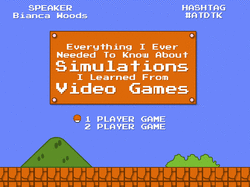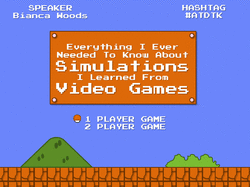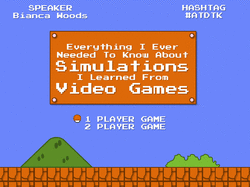Everything I Ever Needed to Know About Simulations I Learned From Video Games
Additional Resources
During my presentation I referenced a number of resources that you can use to learn more about graphic design basics. To make your life easier, I've collected them all here.
The Actual Slide Deck

Click here to download a copy of the slide deck I used for this presentation:
- PowerPoint
- Want the old school game font I used in this presentation? It's available here for free!
Games you should check out

I honestly believe that playing any video game can help you gain insights into creating better sims. That said, there are a few specific games that I'd recommend for being particularly helpful and relevant (plus, they're all also tons of fun).
- The Walking Dead: Season 1: Yes, I'm going to specify Season 1 because I didn't like Season 2 much at all. The first season, though, is an amazing and heart-wrenching example of using choice and branching to let the player control a story.
- Lifeline: This text-based game involved a stranded astronaut who reaches out to you for help. Simple decisions and complex story branching means this story can go drastically differently depending on the choices you make.
- The Yawhg: Want a game to play with friends? Want to see how to make choice drastically change the outcome of a game? Want to possibly become a werewolf? Then find three buddies and try out this game.
- Papers Please: The concept of this game, checking paperwork at a border crossing, sounds tedious at best. You'll be surprised at how quickly you get sucked in to this game's world. This game is fantastic at immersing you in an environment and showing how stress and difficult situations can influence the decisions you make.
- Spent: This cross between a sim and a game puts you in the shoes of a person with a drastically limited income and asks you to make difficult decisions about how to spend your money (or not spend your money) as you try to make it through a month and not go into debt. It's a simple game, but it's fantastic at quickly getting you to understand another point of view.
- The Room: If you like puzzle games, then this is the game for you! This is also one of the best examples of a game that gets making interacting with a 2-D object feel like a 3-D one.
Other resources

Here are a few more links that can help you explore games and sims even further:
- As promised, here's a short list of sample questions you can use to start building a learner profile. It's not every possible question, but it should help get you started.
- This article on personas is another great resource for ideas on how to create learner profiles.
- Back in 2012 (I can't believe it was that long ago) I wrote a blog post on media you should check out if you're going to design a branched simulation. I'm still behind every suggestion, so feel free to check out the post here.
- On a related note, I also wrote an article on simulation creation tools for every budget. It's a decent read if you know you want to put together a sim, but you're not sure what tool to use.
- Several years ago at TechKnowledge I ran a session on how to build your own sim. You can check out my deck, speaking notes, and additional resources here.
- If you're interested in backing a video game on Kickstarter, you're in luck! They actually have a whole section of their site devoted to games you can back. New Kickstarter campaigns launch each day, so it's worth checking this section of the site every so often to see if anything interesting pops up.
- Remember how I suggested you check out your local independent game developer groups? Well, here's one of the great ones from my hometown: the Toronto chapter of the International Game Developers Association (IGDA). They run amazing talks throughout the year, and they even let non-developers like me tag along. Don't fret if you're not in Toronto, because they have posted some of these talks to their YouTube channel.
- Speaking of the Toronto IGDA, they ran a session with multiple speakers back in 2014 that has two talks you might want to check out. The first is for those of you who want to create better digital environments: what interior design can teach you about designing better game environments. The second, though, is one I recommend every one of you take a few minutes to watch: how a developer created a tutorial that taught players how to play a game. It's got iterative design, prototyping, playtesting... plus it's all about how to design a training experience. What more could you want?
- Finally, do you want to completely spook yourself with examples of the uncanny valley that I deems to darn creepy to want to show in the session? Well, go right ahead and click here then. Don't say I didn't warn you though.

